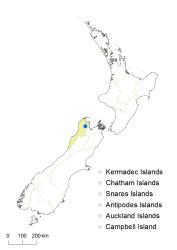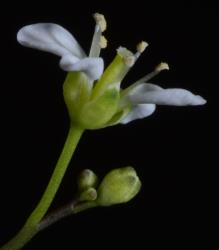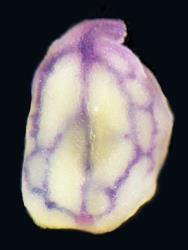Perennial herb, single rosette or with lateral branches. Leaves up to 65 mm long, simple or pinnatisect; lamina 5.0–27.0 × 9.0–20.0 mm, green, membranous, glabrous; petiole up to 65 mm long. Terminal pinna 5.0–19.0 × 4.0–20.0 mm, simple, weakly pandurate to pandurate-orbicular; margin entire, with 2–4 distinct hydathodes; apex obtuse with a distinct hydathode; base cordate. Lateral pinnae 1–2 or absent, 1.5–10.0 × 1.5–6.5 mm, orbicular to broadly elliptic-orbicular, weakly pandurate; apex obtuse; base obtuse; petiolule up to 2.0 mm long. Cauline leaves similar to rosette leaves but smaller, narrower, lateral lobes more prominent, base attenuate. Inflorescence racemose, often branched, each raceme 5–15-flowered; peduncle up to 300 mm long, 0.4–1.0 mm diam. at base, ascending, glabrous. Pedicels 8.0–16.0 mm long, 0.25–0.4 mm diam., glabrous. Sepals 2.0–2.4 × 1.0–1.3 mm, elliptic-oblong to broadly elliptic-obovate, saccate, green, glabrous, margin white and membranous, apex obtuse, base truncate. Petals 4.1–4.5 × 1.9–2.3 mm, white, limb obovate; apex obtuse; base attenuate to cuneate, tapering to a 1.0–1.2 mm-long claw. Stamens 6; median filaments 4, 3.0–3.5 mm long; lateral filaments 2, 2.7–2.8 mm long; anthers 0.4–0.6 mm long, cream to pale yellow, when dehiscent held at a similar height to or slightly below the stigma. Ovary 3.0–3.4 mm long, 0.5–0.6 mm diam., ± terete, green, glabrous; ovules 15–22; style 0.3–0.4 mm long, ± terete; stigma c. 0.4 mm diam. Siliques 10.0–22.0 × 1.1–1.3 mm, glabrous, style 0.1–0.2 mm long; valves grey-brown to grey-green at maturity and when dehiscent; replum 0.3–0.4 mm wide. Seeds 1.1–1.6 mm long, 0.6–0.8 mm wide, 0.4–0.8 mm thick, oblong, broadly oblong, ovate-oblong to obovate-oblong, green, henna-green to henna; veins of embryo cotyledons usually strongly but sometimes weakly coloured violet-purple; wing absent.
Cardamine porphyroneura is distinguished from C. dactyloides by its larger growth habit and leaves, cauline leaves with broad pinnae, petals narrower, anthers cream to pale yellow, seeds narrower and slightly smaller, and the cotyledons of the seed embryo with violet-purple veins.
South Island: Western Nelson.
Cardamine porphyroneura occurs in Western Nelson (South Island), where it is restricted to rocky outcrops near Cobb Reservoir.
Cardamine porphyroneura occurs on shaded ledges and crevices of base-rich talc magnesite outcrops cliffs, scarps, and tors.
Cardamine porphyroneura is assessed as having a conservation status of Threatened, Nationally Critical A(3), with the qualifier One Location (de Lange et al. 2018).
Flowering December–January; Fruiting January.
Previously known by the tagname C. “Cobb magnesite mine” (e.g., de Lange et al. 2013, p. 63).









